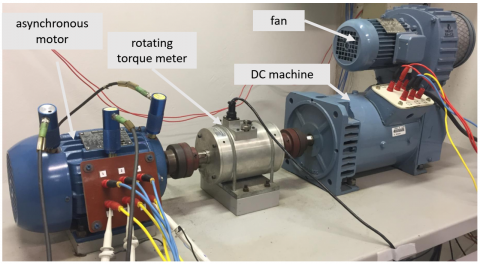Datasets
Open Access
Experimental database for detecting and diagnosing rotor broken bar in a three-phase induction motor.
- Citation Author(s):
- Submitted by:
- NARCO AFONSO MA...
- Last updated:
- Thu, 09/24/2020 - 16:12
- DOI:
- 10.21227/fmnm-bn95
- Data Format:
- Links:
- License:
 27255 Views
27255 Views- Categories:
- Keywords:
Abstract
The data set contains electrical and mechanical signals from experiments on three-phase induction motors. The experimental tests were carried out for different mechanical loads on the induction motor axis and different severities of broken bar defects in the motor rotor, including data regarding the rotor without defects. Ten repetitions were performed for each experimental condition.
Experimental Setup:
The experimental workbench consists of a three-phase induction motor coupled with a direct-current machine, which works as a generator simulating the load torque, connected by a shaft containing a rotary torque wrench.
- Induction motor: 1hp, 220V/380V, 3.02A/1.75A, 4 poles, 60 Hz, with a nominal torque of 4.1 Nm and a rated speed of 1715 rpm. The rotor is of the squirrel cage type composed of 34 bars.
- Load torque: is adjusted by varying the field winding voltage of direct current generator. A single-phase voltage variator with a filtered full-bridge rectifier is used for the purpose. An induction motor was tested under 12.5, 25, 37.5, 50, 62.5, 75, 87.5 and 100% of full load.
- Broken rotor bar: to simulate the failure on the three-phase induction motor's rotor, it was necessary to drill the rotor. The rupture rotor bars are generally adjacent to the first rotor bar, 4 rotors have been tested, the first with a break bar, the second with two adjacent broken bars, and so on rotor containing four bars adjacent broken.
Monitoring condition:
All signals were sampled at the same time for 18 seconds for each loading condition and ten repetitions were performed from transient to steady state of the induction motor.
- mechanical signals: five axial accelerometers were used simultaneously, with a sensitivity of 10 mV/mm/s, frequency range from 5 to 2000Hz and stainless steel housing, allowing vibration measurements in both drive end (DE) and non-drive end (NDE) sides of the motor, axially or radially, in the horizontal or vertical directions.
- electrical signals: the currents were measured by alternating current probes, which correspond to precision meters, with a capacity of up to 50ARMS, with an output voltage of 10 mV/A, corresponding to the Yokogawa 96033 model. The voltages were measured directly at the induction terminals using voltage points of the oscilloscope and the manufacturer Yokogawa.
Data Set Overview:
- Three-phase Voltage
- Three-phase Current
- Five Vibration Signals
Acknowledgements:
The database was acquired in the Laboratory of Intelligent Automation of Processes and Systems and Laboratory of Intelligent Control of Electrical Machines, School of Engineering of São Carlos of the University of São Paulo (USP), Brazil.
Dataset Files
Experimental database of monitoring conditions in three-phase induction motors. banco de dados experimental.zip (6.73 GB)
Open Access dataset files are accessible to all logged in users. Don't have a login? Create a free IEEE account. IEEE Membership is not required.
Documentation
| Attachment | Size |
|---|---|
| 4.59 KB | |
| 161.6 KB |







Comments
the data set is so big, it is difficult to download.
Hi Authors,
could you please explain why voltage and current variables have a different number of values compared to vibration speeds & constant voltage?
We were hoping to use your dataset for training ML models, where each broken bar (r1b-r4) can be considered as a separate label + normal conditions (struct_rs_R1). When I read the mat files in python I am unable to create pandas dataframe due to unequal size of arrays. You may see this also in "Experimental setup.pdf" on the second page.
I am also facing this issue of unequal size of arrays. Did you get resolve this error?
How much is the sampling frequency ?
I figured it out as:
55.611 kHz sampling rate on voltage and amps
1,001,000 samples divided by 18 seconds = 55,611.11 samples per second
All other variables
8.327 kHz sampling rate
149,879 samples divided by 18 seconds = 8,326.61 samples per second
That's what I got and I hope it helps
When use 55.611 kHz as sampling frequency (N_samples/18), the obtained fondamental frequency (Voltage & Amps spectrum) is around 66 Hz !! Is it correct?
The corresponding research articles for this dataset state that the electrical signals were collected at 50 kHz and vibration signals were collected at 7.6 kHz. Note that the signals in the dataset are not exactly 18 seconds long; they are more like 20 seconds long.
What is the Sampling frequency?
What is the Trigger signal in the dataset? It is mentioned in the PDF file that it is a "Constant voltage 5V" signal, but that is not correct when I plot the Trigger signal. It is more like a step signal that goes from 0 to 6 V.
Broken Rotor Fault Detection in AC Induction Motors Using Vibration and Electrical Signals
while executing the command below, I receive the error
>> T = read(ens)
Error using predmaint.internal.pmdata.PMDatastore/read
The value of 'memberData' is invalid. Expected memberData to be one of these types:
table
Please tell me how to remove or troubleshoot it?
After clicking on Experimental database of monitoring conditions in three-phase induction motors in Data file I got the data format in winamp. So how to access it?
I also tried this , I have subscribed to data port. followed the Instructions for c a Dataset on IEEE DataPort,
Could not get Options to access the dataset files either via the AWS S3 URI tab or the Download tab in the upper right hand side of the page.
Kindly give suggestion.
What is the Resolution of aquisition system? 16 bits, 14 bits, ...?
I used Excel to plot the graph, but the three-phase voltage has no phase difference. Why?